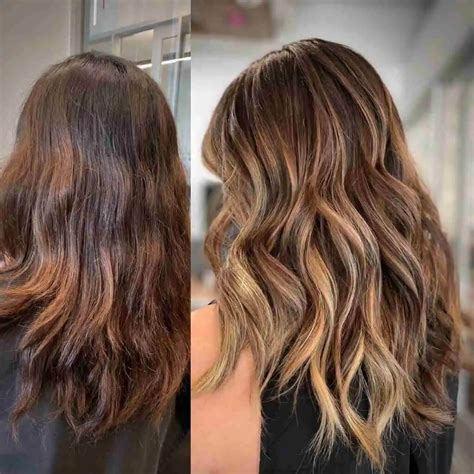Understanding the Differences
Balayage, a French technique that means “to sweep,” has become a popular hair coloring method for its natural-looking results. It involves hand-painting bleach or lightener onto specific sections of the hair, creating a gradual, sun-kissed effect. While both partial and full balayage offer their unique benefits, understanding the differences is crucial for making an informed decision.

Partial Balayage: Subtlety and Precision
Partial balayage, also known as “half-head balayage,” involves highlighting only selected areas of the hair, typically around the face and crown. This technique is ideal for those seeking a subtle and low-maintenance update, or for those with naturally darker hair who want to add depth and dimension.
Benefits of Partial Balayage:
- Natural, face-framing highlights
- Gradual transition from root to tip
- Low maintenance and longer-lasting than full balayage
- Can enhance natural hair color or create a subtle change
Full Balayage: Bold and Dramatic
Full balayage, on the other hand, involves sweeping lightener onto most or all of the hair’s surface. This creates a more dramatic and transformative effect, resulting in a sun-kissed, beachy look. Full balayage is suitable for those who want a complete hair makeover or have lighter hair that they wish to brighten up.
Benefits of Full Balayage:
- Bold, eye-catching color
- Graduated highlights throughout the entire hair
- Can transform dark hair to lighter shades
- Creates a beachy, summery effect
Choosing the Right Type for Your Needs
The choice between partial and full balayage ultimately depends on individual preferences and hair goals. Here are some key considerations:
| Feature | Partial Balayage | Full Balayage |
|---|---|---|
| Hair Coverage | Selected areas | Most or all of the hair |
| Maintenance | Low, lasts several months | Higher, requires more touch-ups |
| Effect | Subtle, natural | Bold, dramatic |
| Best for | Subtle updates, darker hair | Complete transformations, lighter hair |
Balayage vs. Other Highlighting Techniques
Balayage differs from other highlighting techniques in several ways:
Foiling: Foiling involves wrapping individual strands of hair in aluminum foil after applying lightener, creating a more defined and consistent highlight.
Ombré: Ombré is a two-toned coloring technique where the hair transitions from a darker root to a lighter tip in a more gradual manner.
Dip Dye: Dip dyeing is a trend where the ends of the hair are dyed a bold, contrasting color.
Frequently Asked Questions
Q: How long does balayage last?
A: Partial balayage can last up to 6 months, while full balayage may require touch-ups every 3-4 months.
Q: Does balayage damage hair?
A: Any chemical hair treatment can potentially damage hair, but balayage is less damaging than some other techniques due to its targeted application.
Q: How much does balayage cost?
A: The cost of balayage varies depending on factors such as hair length, stylist experience, and location. Expect to pay anywhere from $100 to $500.
Q: Can I do balayage at home?
A: It is not recommended to attempt balayage at home due to the technical skill required. Professional stylists are trained to achieve the desired results and minimize damage.
Q: Can I balayage over previously colored hair?
A: Yes, but it is important to consult with a stylist to determine the best approach. Over-coloring can lead to damage.
The Future of Balayage: “Bioactive Balayage”
As balayage continues to evolve, innovative techniques are emerging. Bioactive balayage is a cutting-edge concept that involves infusing organic, nutrient-rich ingredients into the hair during the balayage process. This not only enhances the color but also nourishes and revitalizes the hair shafts.
Conclusion
Balayage is a versatile hair coloring technique that offers both partial and full coverage options. Understanding the differences between partial and full balayage is essential for choosing the most appropriate method for individual needs and hair goals. With its ability to create natural-looking highlights to bold transformations, balayage remains a popular choice for those seeking a sun-kissed, effortless look.
